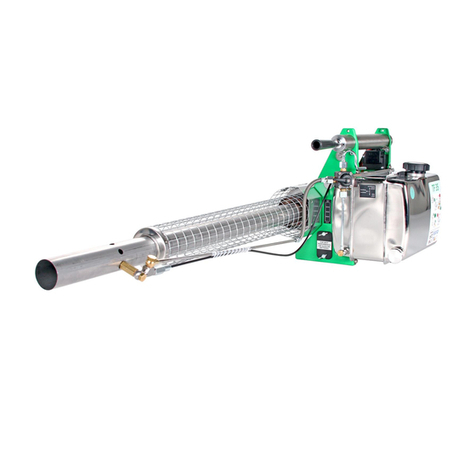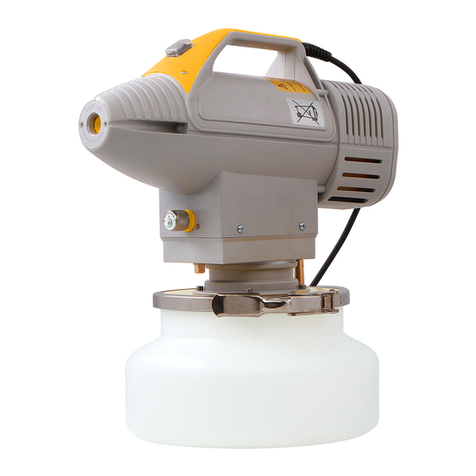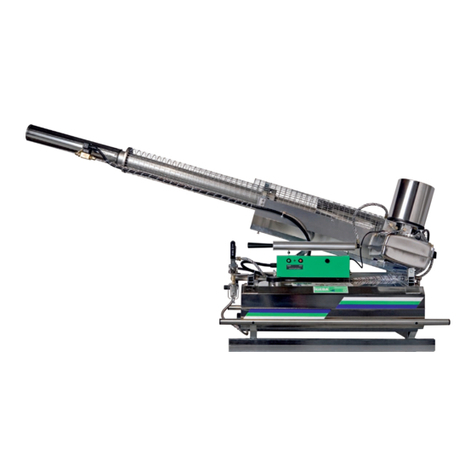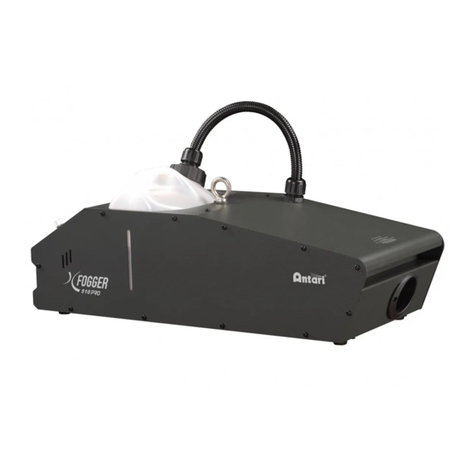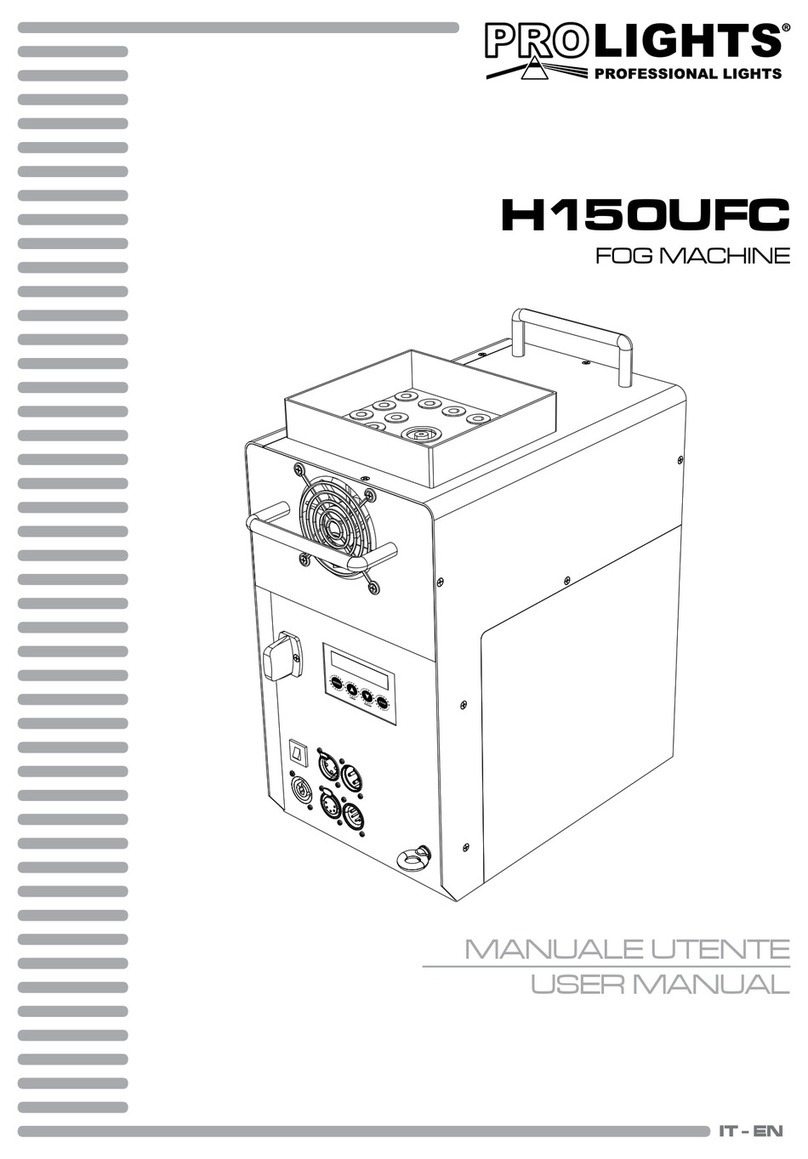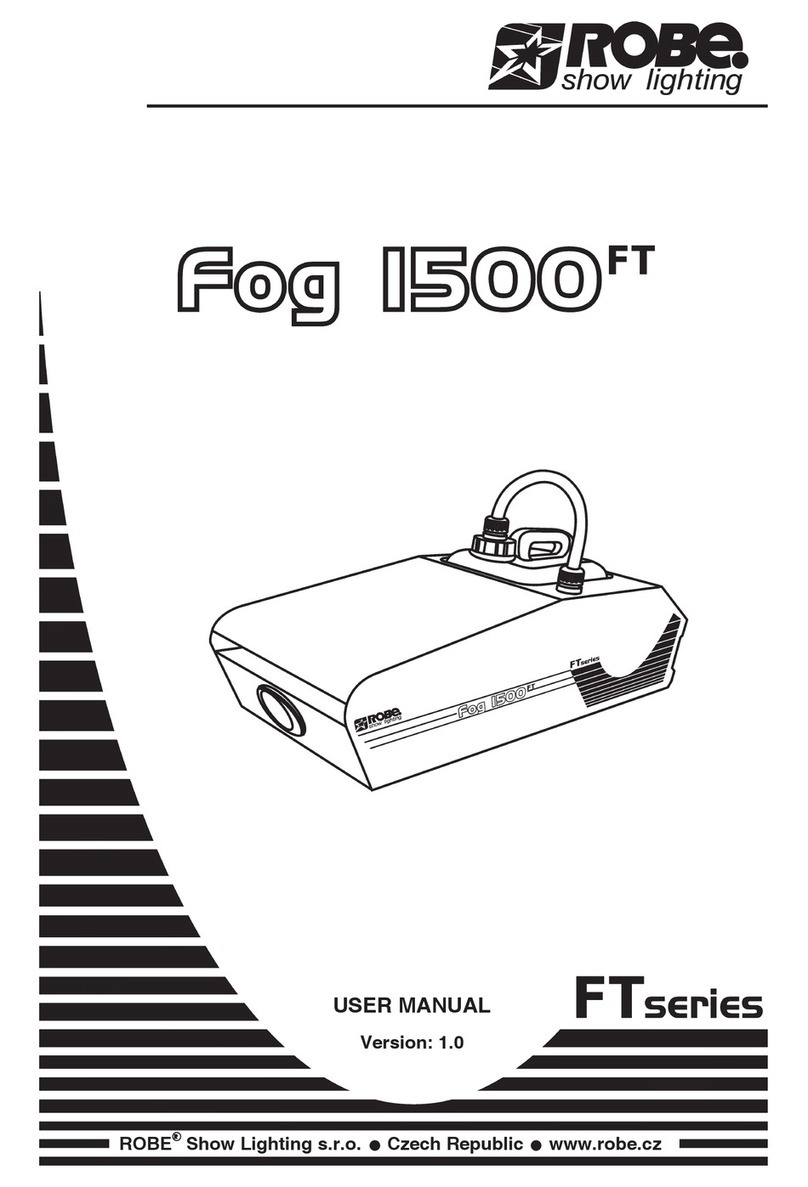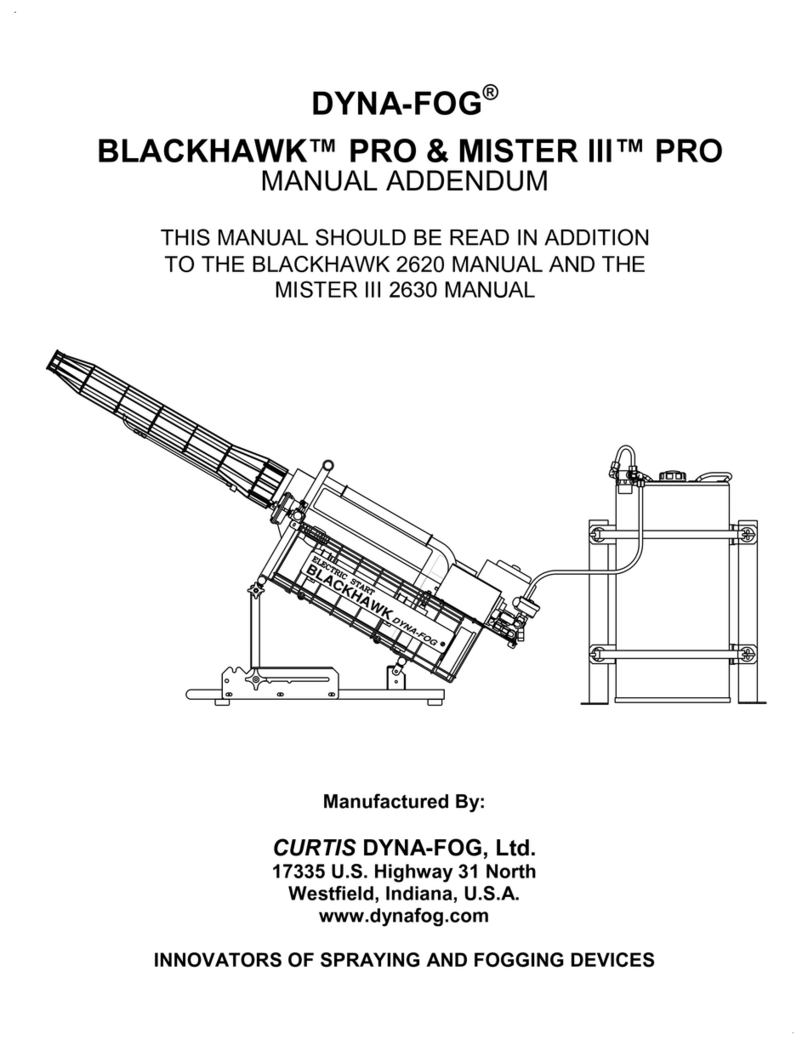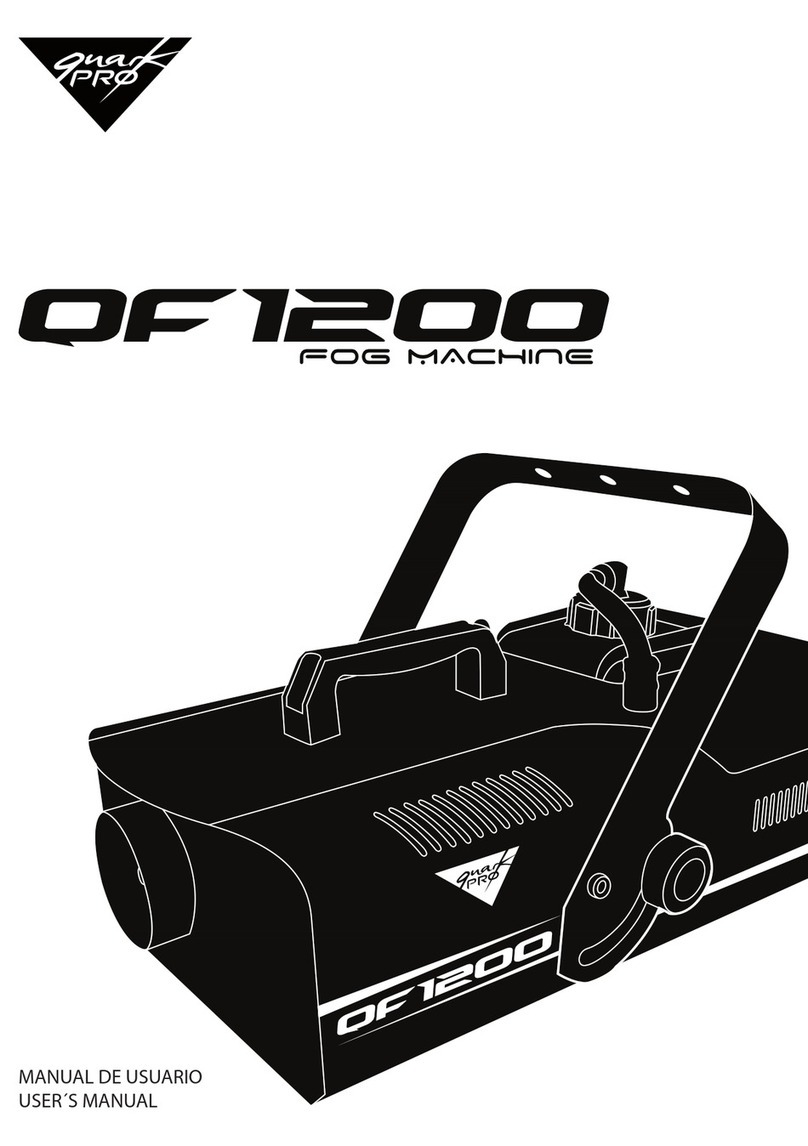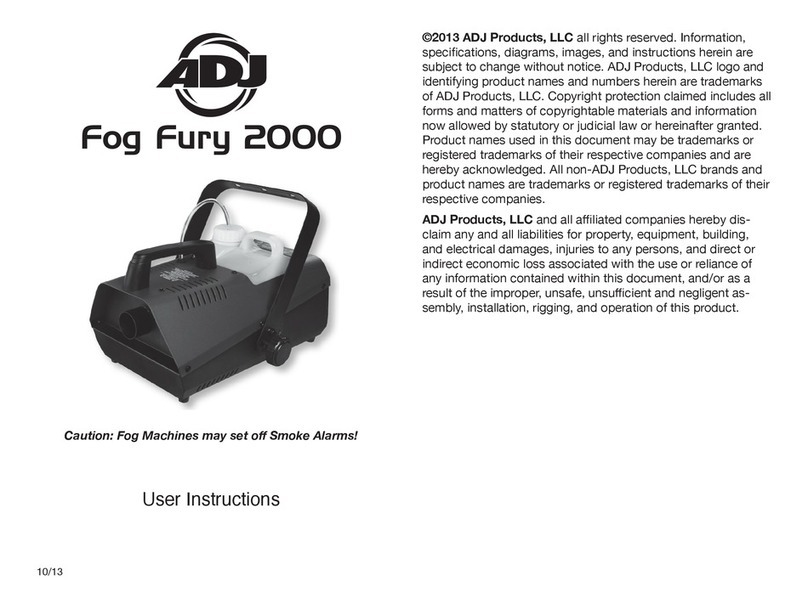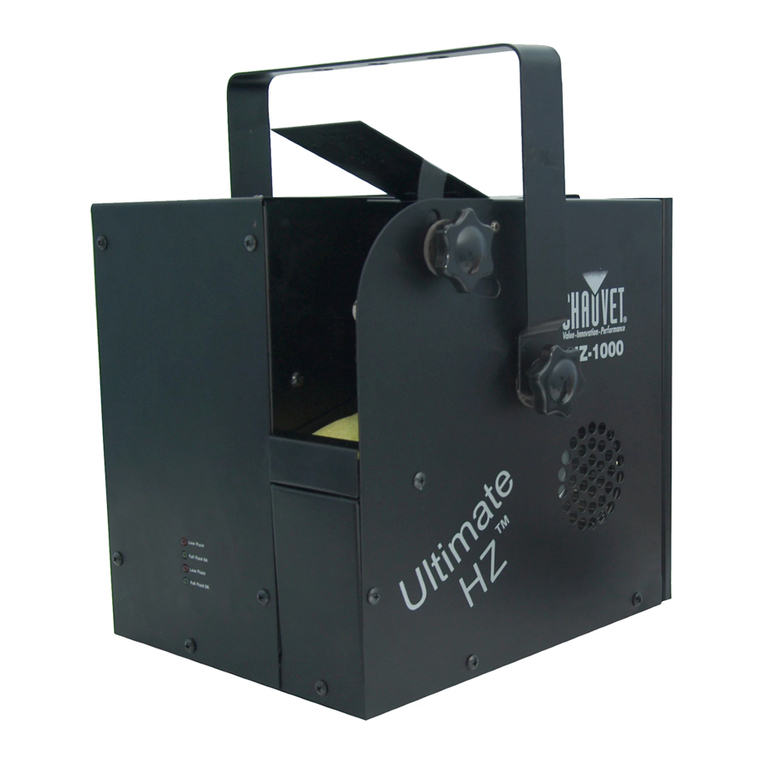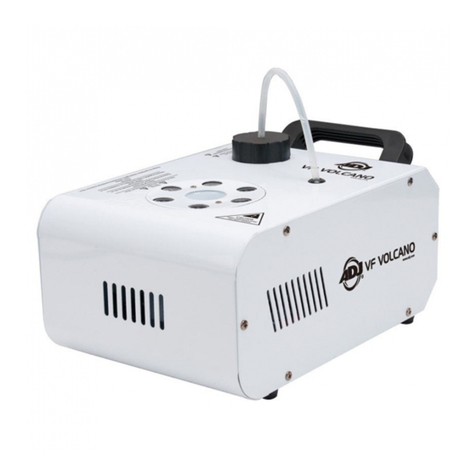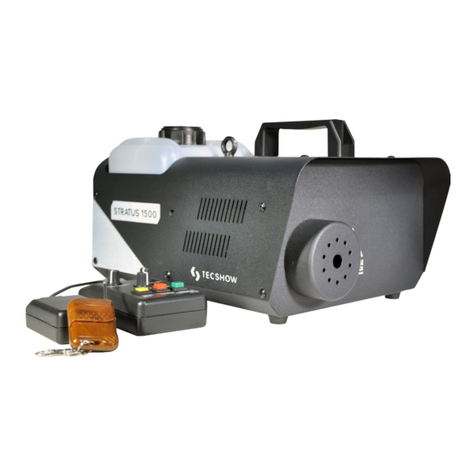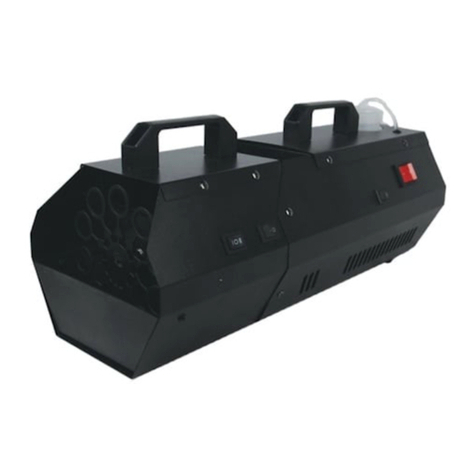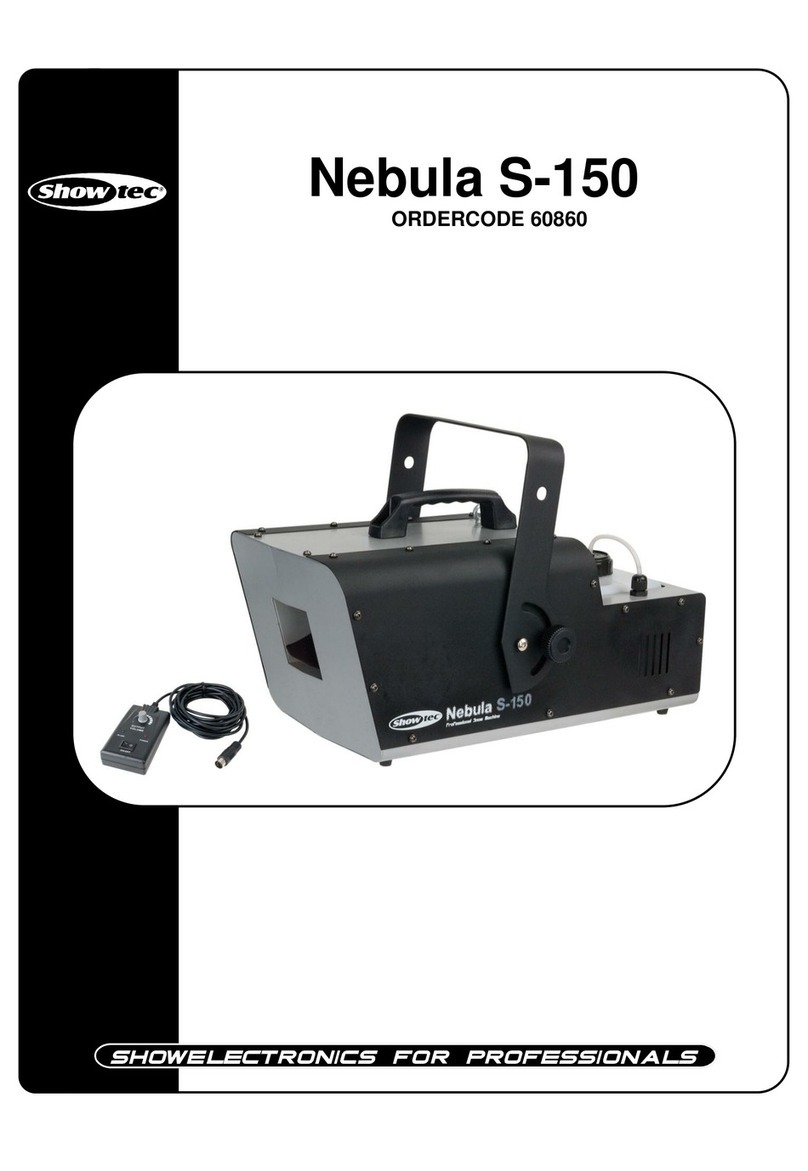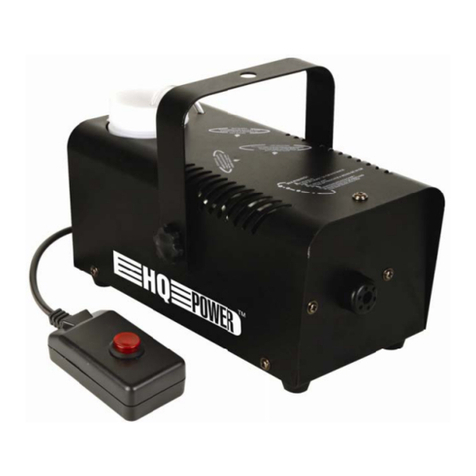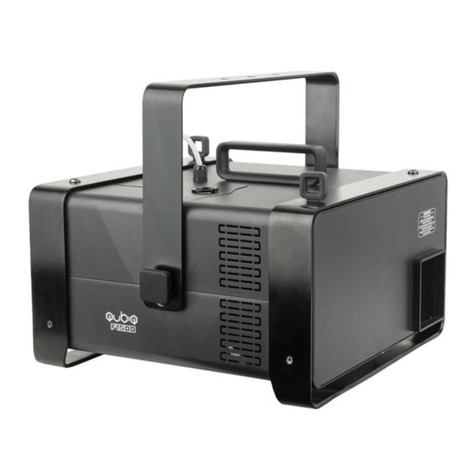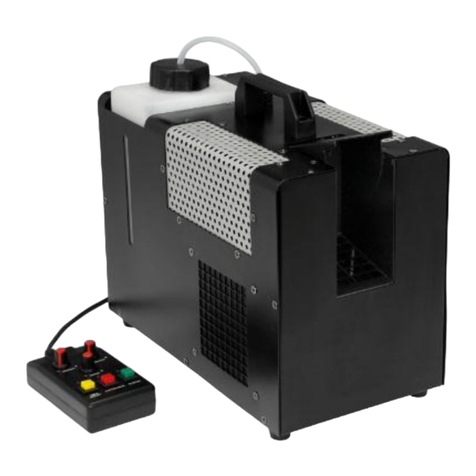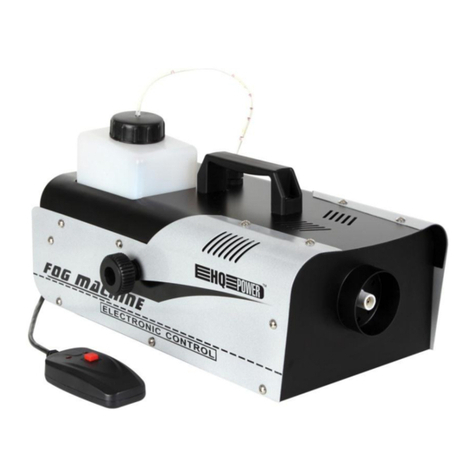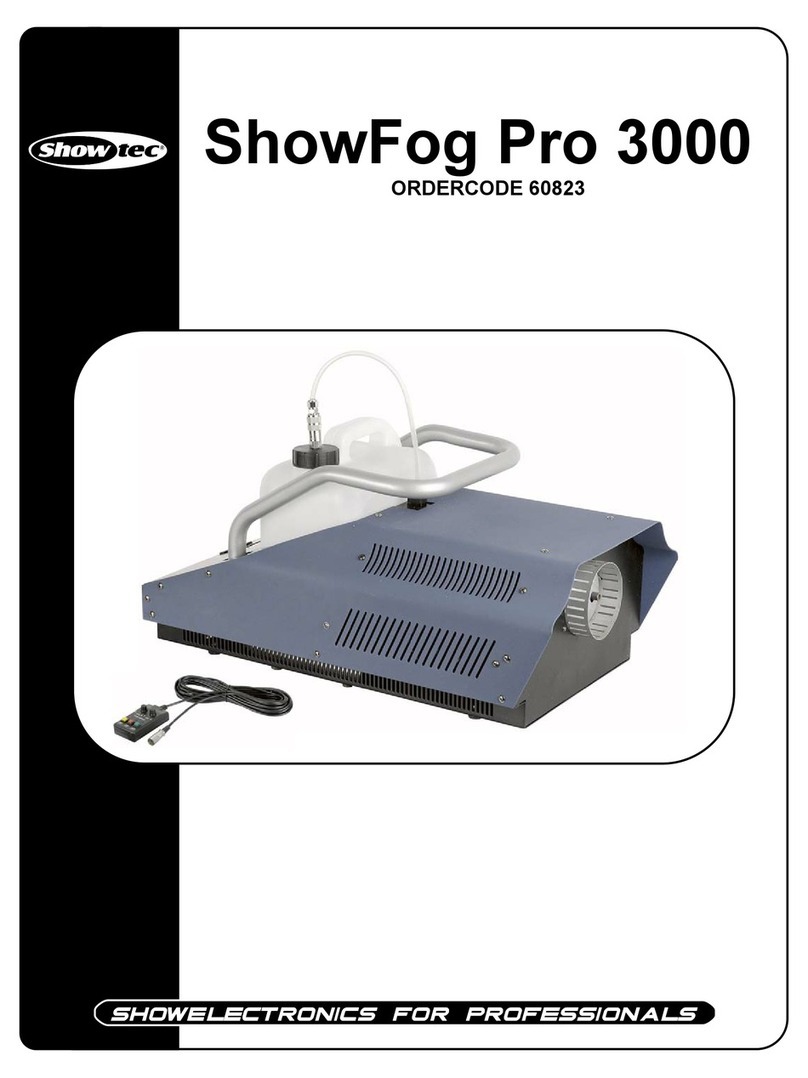IGEBA TF 34 User manual

1
Nebulizador /
Fog Generator
Instrucciones de
funcionamiento
Instruction Manual
TF 34

2
Estimado cliente:
¡ Le felicitamos por la compra de un producto de calidad IGEBA y le
deseamos mucho éxito en su aplicacion !
Para mejor entender las instrucciones de uso, las piezas del equipo descritas en el texto
vienen con un número de posición puesto en párentesis. Con el número de posición en el texto y con
ayuda del dibujo de explosión, todas las descripciones en el manual se pueden coordinar fácilmente.
Cuando haga pedidos de piezas de recambio, es imprescindible indicar el número de posición,
la denominación de la pieza y el número de la pieza, especificados en la lista de piezas de recam-
bio.
Dear customer,
Congratulations for the purchase of our IGEBA quality product and we wish you every success in the
employment of this equipment.
For a better understanding of the Instruction Manual parts of the unit
described in the text of the Instruction Manual are often combined with an
item number in brackets. By using the item no. combined with the explosion drawing all descriptions
in the Instruction Manual become clear.
If you send us an order for spare parts, always mention the item number,
the part number and the spare parts name out of the spare parts list.
IGEBA Geraetebau GmbH Fog Generators and
ULV Aerosol Generators are only Original Made in
Germany with the
3D hologram fixed on the unit.
IGEBA Geraetebau GmbH Nebulizadores Térmicos
y Generadores de Aerosol UBV son solamente
Originales Fabricado en Alemania con el
3D holograma fijado en la unidad.

3
Campos de aplicación limitados
Los modelos TF 34 / TF 34 E permiten la aplicación de soluciones químicas (formulaciones) que
producen una niebla na de aerosoles. Estos equipos están dedicados exclusivamente para las
siquientes aplicaciones:
● Control de plagas y vectores ● protección de cultivos
● protección de existencias (comida, tabaco, algodón)
●hygiene y desinfección
ualquier otro uso aparte de los mencionados anteriormente se toman como uso no dedicado.
El manual de instrucciones debe quedarse en mano del usuario por las indicaciones de seguridad
muy importante descritas. Pasando o vendiendo el aparato a otra persona, el propietario debe
garantizar que el manual de instrucciones se quede con el equipo.
Antes de poner en servicio el equipo, el usuario debe leer este manual de instrucciones cuidado-
samente para familiarizarse con todos los detalles, especialmente con los riesgos y medidas de
seguridad.
Riesgos para el usuario y el ambiente pueden surgir debido a un manejo falso o uso no dedicado.
Daños que de éllo resultarían, están fuera de la responsibilidad de IGEBA.
Restricted fields of application
The units TF 34/ TF 34E are suitable for transforming chemical solutions (formulations) into nest
aerosol fog. The units are exclusively restricted to the following
elds of application:
● Pest and vector control ● Protection of crops
● Protection of stocks (e.g. foodstu, tobacco, cotton)
All other applications are regarded as forbidden elds of application.
The owner of TF 34/ TF 34E must give the Instruction Manual to the user, because of the safety
instructions described in the Instruction Manual. If the owner would sell the unit to another per-
son, then the owner has to guarantee that the Instruction Manual is attached to the unit.
Before starting the unit, user must read the Instruction Manual with due diligence. User must be
familiar with the above applications, especially with all risks and
safety precautions in order to avoid damage.
Risks for persons and environment could arise out of faulty operation and out of forbidden elds
of application. Damages due to faulty operation of the unit and usage in forbidden elds of appli-
cation are consequently out of IGEBA’s responsibility.
IGEBA Geraetebau GmbH
Nebulizador /
Fog Generator TF 34

4
Los más importantes elementos de mando del TF 34 de una mirada/
The important functional parts of TF 34 at a glance
tubo nebu-
lizador/
Fog tube
bomba de aire/
Air pump
llave de agente
activo/solution tap
tanque de
agente activo/
Solution tank botón de pa-
rada/
Stop button
aguja reguladora/
Regulating needle
tanque de
gasolina/
Fuel tank
Indice Directory Página/Page
Principio del funcionamiento del nebulizador Mode of operation 5
Instrucciones de seguridad Safety Instructions 10
1. Preparar el aparato para su uso 1. How to prepare unit ready for use 15
Fijar la cantidad de paso del agente activo Solution output through dosage nozzles 15
Activador agente y aditivos Formulations and fogging additives 16
2. Arrancar el aparato y nebulizar 2. Starting the unit 17
3. Parar el aparato 3. Stopping the unit 17
4. Limpiar el aparato 4. Cleaning the unit 18
5. Detectar fallos 5. Fault finding 19
6. Ejecución especial TF 34 ”E” 6. Model TF 34 E 22
Especificaciones técnicas y accesorios Technical specifications and accessories 26
Lista de piezas de recambio TF 34 Spare parts list TF 34 27
Lista de recambios adicional ”E” corte emergencia Spare parts list for emergency 46
solo en el modelo TF 34 ”E” cut-off Device (only TF 34 E)
pitón nebulizador con
boquilla dosificadora/
fog solution socket
with dosage nozzle
Standard TF 34

5
Funcionamento del nebulizador
El aparato funciona según el principio de una lanza
para riego abierta en un extremo (tubo Schmidt
Argus) con una válvula en el extremo de entrada
(carburador) y con escape abierto. Este sistema con
carburator, tubo mezclador, cámara de combustión
y tubo de expansión constituye un sistema acústico
de oscilación, en el cual tienen lugar fenómenos
de cambio de gases a una cierta frecuencia. En el
caso del presente aparato, la frecuencia de trabajo
es de aproximadamente 110 Hz. El el tubo de
expánsion – mejor dicho: tubo oscilante – pueden
introducirse líquidos en el chorro pulsante de gas
por el extremo que se encuentra en la parte de
salida. La alta frecuencia de la columna de gas o la
alta velocidad de gas, respectivamente, permiten la
introducción y división de soluciones inamables y
suceptibles a descomposición química, sin correr
peligro de que se descompongan debido a tiempos
de espera extremadamente cortos en el chorro de
gas. La alta temperatura del gas provoca el efecto
óptico de una niebla visible, debido a evaporización
de un componente determinado de la solución del
agente activo, p.e. aceites.
Mode of operation
The Fog Generator operates on the principle of the
one-sided open jet-tube (Schmidt-Argus-Tube) with
a valve at the inlet side (carburettor) and an open
outlet (fog outlet). This system – operating without
any moving parts – with carburettor, mixer tube,
combustion chamber and resonator constitutes an
acoustical oscillation system at a certain frequency.
This Fog Generator works at an operating frequency
of abt. 110 cycles/second. Liquids (chemical for-
mulations, oils, etc.) can be fed into the pulsating
gas stream of the resonator at the outlet end. The
high frequency of the gas allows the application
and break up of solutions, otherwise susceptible
to combustion or de-composition, due to the very
short time they are exposed to the hot gas stream.

6
Declaración de conformidad
Declaration of conformity
El fabricante
The manufacturer
IGEBA Geraetebau GmbH
Heinrich-Nicolaus-Straße 15
87480 WEITNAU | Germany
declara de acuerdo con las directivas de la CE
declares, that in accordance to the EC-Standards
• Directiva de máquinas / 2006/42/EG
• Machines standard / 2006/42/EG
• Direttiva sulla bassa tension / 2006/95/EG
• Low voltage directive / 2006/95/EG
• Compatibilidad electromagnética / 2004/108/EG
• Electromagnetic compatibility / 2004/108/EG
que los siguientes productos han sido fabricados de conformidad con las directivas CE arriba
indicadas:
the following product-line is produced in accordance to the above-mentioned EC-Standards:
Objeto Termonebulizadores
Subject Thermal Foggers
Modelo / Typ TF 34 - 35 - 60 - 65 - 95 - 160 - EVO 35
y cualquier de sus variantes/
and their other versions/
Se han aplicado las siguientes normas/
The following standards are used/
Norma/Norm Titel/Title
DIN EN 12100 Seucridad de maquinarias
Safety of machines
DIN EN ESO 13857 Distancias de seguridad
Safety distances

7
¡Se encuentra disponible una documentación técnica con instrucciones de servicio, esquemas
de circuitos, listas de recambios y dibujos de despiece!
A technical documentation with manual, wiring diagrams, spare parts list and exploded view
is available!
Atención: 1) Estos aparatos sólo pueden ser operados por personas debidamente formadas.
2) Queda absolutamente prohibida la nebulización de líquidos inamables en espacios
cerrados. Para más indicaciones, consulte el manual de instrucciones.
3) Deberán seguirse las recomendaciones de dosicación de los fabricantes de
los medios
Attention: 1) The operation of these units has to be made only by well instructed people.
2) The fogging of ammable liquid in closed areas is absolutely forbidden.
Advices in the manual.
3) The recommendations of the producers of the liquids are strictly obligatory
Persona autorizada, para la compilación de los documentos technicos es:
Carlos Jaramillo – IGEBA Geraetebau GmbH – Weitnau | Germany
Authorized Person, for the assamble of technical documentation are:
Carlos Jaramillo – IGEBA Geraetebau GmbH – Weitnau | Germany
Weitnau, Enero/January 2014
IGEBA Geraetebau GmbH
Alberto Sabatini Joerg Heckel

8
Aviso y reglamento de seguridad Warning notes and safety regulations
Rebuscar el manual de
instrucciónes Read instruction manual
Llevar orejera Wear ear protection
Llevar respiración respiratoria Wear respinatory equipment
Atención – supercie caliente Attention hot surface
Baterías desgastadas se tienen
que eliminar aparte. ¡ Nunca su-
ministre baterías viejas y partes
electrónicas a la basura !
Hand in old batteries at
collection point! Never dispose
old batteries and electronic
components as domestic waste.
Lleve puestos protectores
auditovos Wear protectiv goggles
Lleve puestos quantes de
protección DIN EN 407
Wear safety gloves acc.
DIN EN 407
No dejen marchar el aparato
sin vigilancia.
Never leave the fogger
unattended during operation.

9
Marcado CE
Manual de instrucciones resumido
colocado en el aparato.
Short manual instructions fixed on unit.
Este aparato, en la versión sumini-
strada, cumple todos los requisitos
de las directivas de la CE 2004/108/
CEE „Compatibilidad electromag-
nética“ y 2006/42/EG la directriz
maquenaria
CE marking
The shipped version of this device
complies with the requirements
of the EEC directives 2004/108/
EEC “Electromagneticcompatibility”
and the machine directive 2006/
42/EG
TF 34

10
¡Lean las instrucciones de seguridad!
El operador quien trabaja con el equipo debe
familiarse con las medidas de seguridad antes
de poner en servicio el aparato. Solamente se
debe permitir a personas formadas y autorizadas
manejar el equipo.
1. El operador debe haberse enterado de las reglas
en vigor acerca de medidas para la prevención
de accidentes, y debe seguirlas al trabajar con
aparatos accionados por gasolina.
2. Es absolutamente prohibido fumar cuando se
trabaja con combustibles. No debe haber fuego
abierto ni otras fuentes de calor.
3. Nunca rellenen el tanque de gasolina si la tem-
peratura del aparato sigue alta. Existe peligro de
incendio o explosión.
4. Tengan atención de no derramar la gasolina
cuando llenen el tanque. Usen el embudo IGEBA
con tamiz. En caso de derrame de gasolina, usen
trapos secos para limpiarlo.
5. Nunca operen el aparato cuando haya gases
o materiales combustibles en las proximidades.
Existe peligro de incendio y explosión porque el
equipo trabaja con una llama libre en el resonador.
En todo caso eviten el contacto directo entre el
tubo nebulizador caliente y otros materiales ya que
éstos podrían ser dañados por la alta temperatura.
6. Se prohibe la nebulización en interiores con par-
tículas ultrafinas inflamables (p.ej. silos de grano)
porque existe peligro de una explosión de polvo.
7. Se prohibe nebulizar en interiores cerrados en
los que se encuentran llamas abiertas, luz de can-
dela, máquinas calientes o instalaciones eléctricas
ya que existe peligro de incendio.
8. Al nebulizar en interiores cerrados, tengan en
cuenta que la nebulización podría provocar incen-
dios o explosiones si la concentración de niebla en
la habitación excediese un nivel crítico. No nebu-
licen más tiempo de lo permitido. Familiarícense
con la dosificación de aditivos combustibles en
ámbitos cerrados. Calculen la cantidad máxima
de aditivos combustibles considerando el tamaño
de la habitación, la cantidad de paso y el tiempo
de nebulización.
9. No se permite transportar el equipo en vehícu-
los cerrados mientras esté aún caliente. Esperen
hasta que se haya enfriado hasta la temparatura
ambiente.
Read Safety Instructions
Before first starting the unit the operator must be
firm with the safety instructions. Only educated
and authorized persons are allowed to work with
the unit.
1. The operator must follow the actual rules for the
prevention of accidents, when working with fuel
and fuel driven units like TF 34.
2. Smoking is strictly forbidden, while working with
fuel. Nearby to the fuel open flames or other hot
thermal sources are not allowed.
3. Do not fill the fuel into the fuel tank, as long as
the temperature of the unit is still high. Danger of
fire and explosion exist.
4. Do not spill fuel, when filling the fuel tank. Use
the IGEBA funnel with strainer. In case of spilling
fuel, use a dry cloth and take residual fuels away
from the unit.
5. Never operate the unit, when combustible
materials or gas are nearby. Danger of fire and
explosion exists, because their is an open flame
inside of the fogging tube. Avoid direct contact
between the hot fogging tube and other materials,
because materials will be damaged due to the
high temperature.
6. It is forbidden to fog in rooms with finest com-
bustible dust particles (i.e. grain silo), because
danger of dust explosion exists.
7. It is forbidden to fog into enclosed rooms where
open flames, candle lights, hot engines or electrical
appliances exist, there is fire danger.
8. When fogging in enclosed rooms, take into ac-
count that fogging can lead to fire and explosions
if the concentration of fog in a room exceeds a
crucial value. This is due to the combustible addi-
tives of such a fog. Do not fog longer than allowed
into enclosed rooms. Make yourself familiar with
the dosage of combustible additives in enclosed
rooms. Calculate the maximum quantity of com-
bustible additive depending on room size, nozzle
size and fogging time, before you start fogging
into enclosed rooms.
9. It is not allowed to transport the unit in a closed
vehicle, as long as the unit is hot. Wait until the unit
has cooled down to ambient temperature.

11
10. No dejen marchar el aparato sin vigilancia y
tambien en el período del enfriamiento hasta que
lleque a la temperatura ambiente, ademas es
prohibido te tener un combustible médium cerca
del Termonebulizador.
11. Cumplan con las especificaciones del fabri-
cante de agentes activos en cuanto a dosificación
y medidas de seguridad. Al llenar el tanque de
agente activo, siempre utilicen el embudo IGEBA
con tamiz. En caso de derrame, usen trapos
secos para limpiarlo. Cuando se usan agentes
activos irritantes, el operador debe llevar guantes
y gafas de protección. Almacenen o desechen los
productos residuales con cuidado de acuerdo con
las regulaciones legales.
12. Siempre lleven protectores adecuados para
el oído al trabajar con el equipo. El nivel acústico
excede los 90 dBA.
13. Utilicen una máscara respiratoria y ropa protec-
tora. Cuando nebulizen en espacios cerrados,
lleven una máscara con filtro combinado contra hu-
mos y disolventes orgánicos. Al nebulizar productos
irritantes, se debe llevar una máscara respiratoria
completa, ropa y guantes de protección.
14. En utilización estacionaria, la unidad debe
mantenerse horizontal en una base sólida. No se
permiten posiciones inestables del equipo.
15. En utilización móvil, transporten el equipo por
la correa de espalda de manera que el lado de los
depósitos esté dirigido hacia su cuerpo, las partes
del aparato que se calientan dando al otro lado.
Lleven la correa en el hombro del mismo lado en
que llevan el aparato, y no se la pongan encima
de la cabeza.
16. No toquen las áreas calientes del equipo puesto
que podrían producir fuertes quemaduras de la
piel. Especialmente el tubo nebulizador, la cámara
de combustión y zonas adyacentes se calientan
en extremo. También las rejillas de protección y la
chapa protectora se calientan por la temperatura
radiante. Eviten tocar también estas partes.
17. Reparaciones deben llevarse a cabo sólo
cuando el aparato se haya enfriado. Después
vuelvan a colocar los dispositivos de protección
previamente retirados.
18. ¡En ningún caso se debe nebulizar si el aparato
no funciona perfectamente!
19. No nebulicen directamente contra paredes,
personas y otros objetos. Mantengan una distan-
cia mínima de por lo menos 3 metros quando el
aparato esta en marcha.
10. Never leave the fogger unattended during
fogging and cool-down period until ambient tem-
perature is reached, furthermore no inflammable
mediums are allowed nearby.
11. Comply with the specifications of manufactu-
rers regarding safety instructions and dosage of
formulations. Do not spill solution, when filling the
solution tank. Use the IGEBA funnel with strainer.
In case of spilling solution, use a dry cloth and
take residual solution away from the unit. In case
of etching formulations wear protective gloves
and protective spectacles. Store and depose
residual formulations carefully according to legal
regulations.
12. Wear suitable ear protectors when operating the
unit. The noise level of the unit exceeds 90 dBA.
13. Wear a breathing mask and protective clothing
when fogging in enclosed spaces. Use suitable
filters against organic fumes and solvents. When
etching formulations are used for fogging, then
wear a full protection including breathing mask,
protective clothing and protective gloves.
14. In stationary operation the unit must stand
horizontal and stable on a rigid base. Unstable
positions of the unit are not allowed.
15. In mobile operation carry the unit by means
of the carrying belt. When carrying the unit, tanks
show to your body. Do not put the carrying belt
onto hot areas of the unit. Carry the belt at the
same shoulder side which has to carry the unit.
That means, do not put the belt over your neck.
16. Do not touch hot areas of the unit, because
touching leads to harmful burns on hand and
fingers. Especially the fog tube, the combustion
chamber and adjacent parts gets extremely hot.
During operation the protective covers and the
heat deflector shield heats up due to temperature
radiation. Avoid touching those parts.
17. Repair the unit after the unit has cooled down.
After repair do not forget to reattach heat deflector
shield and protective covers.
18. Do not fog if the unit does not work properly.
19. Do not fog directly against persons, walls or
other objects. During operation keep distance of
minimum 3 m.

12
20. Si el equipo se para debido a una avería o por
falta de gasolina, cierren inmediatamente la llave
de agente activo (palanca apunta hacia arriba).
Inclinen ligeramente hacia abajo el tubo nebuliza-
dor para que el agente activo restante pueda salir.
¡Atención! El producto líquido es inflamable y puede
encenderse. Tengan preparado un recipiente de
metal adecuado para recoger la solución.
21. Nunca arranquen el aparato si el cuerpo de
desplazamiento está destornillado de la cámara
de mezcla (carburador) pero aún conectado al
encendido. El tanque de gasolina estando abierto,
una chispa de encendido podría encender los
vapores de gasolina. Existe peligro de explosión.
22. Se prohibe reconstrucción/modificación
cualquiera del equipo. Sólo utilicen repuestos y
accesorios originales de IGEBA.
23. Si nebulizan en interiores, éstos deben estar
marcados como áreas prohibidas. Presten aten-
ción a que otras personas, especialmente niños,
no tengan acceso.
24. Asegúrense que esté disponible un extintor.
25. Antes de almacenar el aparato durante un
periodo más largo, se deben vaciar los tanques
de gasolina y de agente activo y retirar las pilas
del equipo.
26. Almacenen el depósito con agente activo y el
tanque de gasolina junto con el equipo de tal manera
que no sean accesibles a niños y otras personas.
27. Consideren el equipo como su aparato personal
y manténganlo siempre bajo su responsabilidad.
Lean y sigan las instrucciones de operación y
servicio en las próximas páginas de este manual.
28. En mezclas de sustancias es importante de
considarar los datos del fabricante, para evitar sin
querer reaccíones quimicas.
29. Con un tanque de solucion lleno hay que hacer
caso a las indicaciones del fabricante de las su-
stancias referente a transporte y almacenamiento.
30. Peligro de quemaduras / Peligro de encendio
a tropezar.
31. Dirreción recorrida afrontado al hacer niebla.
Hay que cuidar bastante vista.
20. If the unit stops running due to malfunction or
due to missing fuel, close immediately the soluti-
on tap (lever shows upwards). Slightly incline the
fog tube downwards, so that liquid solution flows
out of the fog tube. Attention! Liquid solution is
inflammable. Use a suitable metal receptacle for
collection of liquid solution.
21. Never start the unit, if the swirl vane is detached
from the mixing chamber (carburettor) but still
connected with the ignition. If fuel tank is open,
ignition sparks could inflame fuel or fuel vapour.
Danger of fuel vapour explosion exist.
22. A reconstruction of the unit without written
permission of IGEBA is not allowed. Use only
original spare parts and accessories from IGEBA.
23. If you fog into enclosed rooms, those rooms
must be marked as forbidden areas and must be
protected against access, especially children.
24. Make sure that a fire extinguisher is available,
before you start working.
25. Before the unit is stored for longer periods,
remove residual fuel, residual formulation and
batteries from the unit.
26. Store formulations, fuel and the unit itself at
places where they are not accessible to children
and other persons, who may not be aware of
dangers involved.
27. Regard the unit as your personal fogger. Keep
the unit always under your responsibility. Read
and follow the operating and service instructions
on next pages.
28. To avoid chemical reaction when mixing dif-
ferent active substances, the instructions of the
manufacturer must be followed.
29. When solution tank is filled, the instructions
of the chemical manufacturer must be followed
regarding transport, storage etc.
30. Danger of burn / burning by stumble.
31. Walking direction should be contrary to the
fogging direction. Pay attention to sufficient sight.

13
Illus. 1 / illus. 1
Illus. 2 / illus. 2
Other and not permitted applications and modifi-
cations of the unit beside the official guidelines.
Modifications of the unit are not permitted without
technical clarification with IGEBA Geraetebau
GmbH and/or their advise.
The unit must no be used as flame thrower and
must not be modified in such way. The device must
never be used against people, farm animals or pets.
The device must not be operated under the influ-
ence of alcohol, medicine or drugs.
Furthermore, objects, body parts, animals etc. must
not be inserted in the openings or leaned on hot
parts of the running or cooled unit.
Otras manipulaciones no permitidas y modifica-
ción del aparato fuera de las directrices oficiales.
No está permitido realizar modificaciónes en el
aparato sin consultar con la empresa IGEBA Ge-
raetebau GmbH y/o sin seguir sus instrucciónes.
Este aparato no puede utilizarse como lanzallamas
o ser modificado de manera que pueda utilizarse
como tal. El aparato no puede dirigirse contra
personas, ganado o animales domésticos.
El manejo del aparato no puede realizarse bajo el
efecto del alcohol, los medicamentos o drogas.
Además, está prohibido introducir objetos, partes
del cuerpo, animales, etc. en las aperturas del
aparato mientras éste está en funcionamiento,
así como apoyarse en partes calientes del mismo

14
Illus. 3 / illus. 3
Illus. 4 / illus. 4

15
1. Preparar el aparato para su uso
- Después de retirar la tapa (71) coloque las pilas
LR20 según el esquema que se encuentra en
la etiqueta (82). Se puede utilizar pilas más
pequeñas, del tamaño LR6 que requiere el
adaptor (86/1). Ponga las pilas LR6 y empuje el
adaptador en el tubo (86). El extremo positivo
de las pilas apuntando al interior del aparato. El
extremo negativo de las pilas esta eléctricamente
conectado con los sportes metálicos del aparato
por el muelle de la cubierta de las pilas (71) y el
tornillo de mariposa (88). Después de insertar
el tubo con las pilas, apriete la tapa (71) con la
mano y empuje el lado perforado sobre el tor-
nillo de mariposa inferior (88) medio atornillado.
Entonces fije el tornillo de mariposa superior (88)
y posteriormente el inferior.
- Controlar el encendido presionado el botón de
arranque (78). Debe oírse bien un zumbido.
- Cerciórese de que el grifo del producto (120) esté
cerrado. La palanca indica hacia arriba.
- Llenar el depósito de combustible (10) usando
el embudo IGEBA con tamiz (142) con gaslolina
>75 RoZ sin aditivos de ninguna clase. El empleo
de gasolina extra no aparte ninguna ventaja.
Después de llenar el deposito se aprieta bien
con la mano la tapa del deposito (7).
- Llenar el depósito de producto (1). Use siempre
el embudo IGEBA con tamiz (141). Coloque
correctamente la tapa del deposito (2) y griarla
hacia la derecha.
Las pilas son accesorios opcionales y deben ser
comprados por separado.
Fijar la cantidad de paso del agente activo por
las boquillas
El aparato TF 34 está equipado con una boquilla
de dosificación de tamaño 0,8. Se adjunta otra
boquilla del tamaño 1,0 como accesorio.
Se ha utilizado agua para determinar las siguientes
cantidades de paso (valores aproximados):
Tamaño de
Boquilla ➝0,6 0,8 1,0 1,2 1,4
Litros/hora ➝5 10 15 20 25
La cantidad de paso defiere hasta un 20% debido
a las distintas propiedades físicas y químicas de
los productos. Recomendamos que hagan sus
propias medidas bajo condiciones concretas. Esto
so refiere sobre a países tropicales.
Cambiar la boquilla:
Quando se cambia la boquilla (117) a atornillar y
desatornillas se tiene que usar incondicional una
segunda llave replicando el elpalme de niebla (114).
1. How to prepare unit ready for use
- After removing the battery cover (71) insert bat-
teries of size LR20, according the scheme on the
label (82). You may also use smaller batteries of
size LR6, which requires the battery insert (86/1).
Put in 4 batteries LR6 and push the insert into
the battery tube (86). The plus pole of the battery
points into unit and the minus pole of the battery
points out of the unit. The minus pole of the battery
is electrically connected with the metal supports
of the unit via the spring of the battery cover (71)
and the wing screw (88). After inserting battery
tube with batteries, press the battery cover (71)
down by hand and push the slotted side over the
lower, half way unscrewed wing screw (88) first.
Thereafter fix the upper wing screw (88) and then
tighten the lower wing screw.
- Check ignition by pressing starter button (78). A
buzzing sound is audible.
- Make sure that solution tap (120) is closed. Lever
of solution tap must point upwards in closed
position.
- Fill petrol tank (10) by using the IGEBA funnel
with strainer (142) with petrol >75 RoZ, without
any additives. There is no advantage in using
higher grade petrol. After filling, place tank cap
(7) in proper position, then turn to the right and
tighten the tank cap.
- Fill solution tank (1). Always use IGEBA solution
funnel with strainer (141). Place tank cap (3) in
proper position, then turn to the right and tighten
the tank cap.
* Batteries are optional accessories and must be
ordered separately.
TF 34 is already equipped with a dosage nozzle
size of 0,8. Another nozzle with size 1,0 is attached
as accessory.
Water has been used to determine the following
outputs (rough values):
Nozzle size ➝0,6 0,8 1,0 1,2 1,4
Liter/hour ➝5 10 15 20 25
The output (liter/hour) differs up to 20% due to
the different chemical and physical properties of
the formulations. We advise you to do your own
metering of the output under prevailing conditions.
If you replace the dosage nozzle (117), then it is
necessary to hold a second spanner against the
fog solution socket (114) when screwing off and
when tightening the dosage nozzle (117).

16
Productos y aditivos
Los productos son una mezcla de una solución activa y
un propelente (aditivo). Los productos para aplicación por
nebulización se entregan mezclados o pueden ser mez-
clados de acuerdo con las instrucciones del fabricante.
Nota: Para nebulizar productos basados en aceites se
tiene que utilizar siempre el TF 34 con el tubo de nebu-
lización estandar (108).
Quando se aplican productos pasados en aqua con
el tubo de nebulización estandar (108), usted va á ver
pequeñas gotitas saliendo en el fin del tubo de nebu-
lización. Estas gotitas se van a caer al suelo, enfrente
de la maquinaria y esas mismas pueden acusar daños
en el suelo si la substancia es agresiva. Para nebulizar
productos basados en aqua por favor utelize el juego de
piezas de aqua para reequipar la unidad (Pos.350-354).
¡El juego de piezas para de aqua para reequipar la unidad
es pieza de repuesto opcional (página 43)!
¡Attención!: Nunca aplicé productos pasados en aceite,
con el tubo de agua (350), peligro de encendio.
Nebol es un aditivo adecuado, en contrasta con agua
produce una niebla visible con excelentes propiedades
de suspensión y tiempos de vida alta.
Nebulización en interiores.
¡Atención! Peligro de incendio.
Cuando se nebuliza en interiores con el TF 34 se debe
tener en cuenta que los productos con aditivos basados
en aceites producirían aerosoles combustibles cuando
se excede una concentratión crítica en una habitación.
La dosificación de propelentes basados en aceite en
productos preperados, no deberian superar las siguientes
concentraciones por 100m3.
Aditivos combustibles
Nebol 0,30 lts. Aceites vegetales 0,25 lts.
Glicerina 0,25 lts. Aceite diesel 0,25 lts.
Ekomist 0,20 lts. Petropal 0,25 lts.
Etilenglicol 0,20 lts. Shell Risella 15 0,15 lts.
Dietilenglicol 0,20 lts. Keroseno 0,25 lts.
VK 2-spezial 0,20 lts.
Estos volúmenes por 100 m3se han establecido para
estar suficientemente por debajo de los límites de infla-
mabilidad. Estos volúmenes se toman como seguros.
Ejemplo:
Hay un edificio con 10 habitaciones que tienen que ser
nebulizadas una por una. Cada habitación tiene 100 m3.
Instrucciones del fabricante respecto a concentración y
volumen de producto en relación al espacio:
10% - solución: 0,05 l/100 m3
Instrucciones del fabricante respecto a mezcla de
producto:
0,5 litros 10% solución
+ 9,5 litros de aditivo (Ej. Gasoil)
10 litros producto
Formulations and fogging additives
Formulations are a mixture of an active solution and a
carrier (fogging additive). Formulations for fogging ap-
plications are delivered as ready mixed formulations or
can be mixed according to manufacturer instructions.
Please note: For fogging oil-based solutions you
have to use TF34 with the standard fog tube (108).
When fogging water-based solutions with the standard
fog tube (108) you will see little droplets of solutions
splashing out of the fog tube together with fog. Those
droplets will deposit on the floor in front of the fogger
and could damage the floor if the solution is aggressive.
For fogging water-based solutions you have to use the
conversion kit for water (Pos.350-354). The conversion
kit for water is an optional accessory (Page 43).
Attention: Never try to fog oil-based solutions with
the water-fog tube(350), there is fire danger.
Nebol is a suitable fogging additive, which produces
quite opposite to water a visible fog with excellent
suspension property and long dwell time.
Fogging in enclosed rooms.
Attention! Danger of fire!
When fogging indoors with TF 34 you have to
take into account that formulations with oil-
based carriers lead to combustible aerosols when
exceeding a crucial concentration in a room.
The dosage of oil-based carriers in ready mixed
fogging formulations should not exceed the following
maximum concentrations per 100 m3:
Combustible fogging additives
Nebol 0,30 l Vegetable oil 0,25 l
Glycerin 0,25 l Diesel oil 0,25 l
Ekomist 0,20 l Kerosene 0,25 l
Ethylenglykole 0,20 l Petropal 0,25 l
Diethylenglykole 0,20 l Shell Risella 15 0,15 l
VK 2-spezial 0,20 l
These volumes per 100 m3have been established to
be sufficiently below the lower limits of inflammability.
These volumes are regarded as safe.
Example:
There is a building with 10 rooms, which has to be
fogged one by one. Each room is 100 m3.
Guides of manufacturer regarding concentration
and volume of the active solution in relation to the
space:
10% - solution: 0,05 l / 100 m3
Guides of manufacturer regarding mixture of for-
mulation:
0,5 liters 10%-solution
+ 9,5 liters fogging additive (e.g. Diesel oil)
10 liters formulation

17
El TF 34 (equipado con la boquilla 0,8) atomizaría 5 litros
de producto en 30 minutos.
¡Atención! El ejemplo apunta dos aspectos,
que son de crucial importancia cuando se
nebulizan interiores:
1) El usuario del aparato no debe nebulizar una habitación
de 100 m3más tiempo del permitido, porque el límite de
inflamabilidad (Ej. 0,2 litros Gasoil) se alcanza en 1,3
minutos de nebulización.
2) El principio activo, que es nebulizado durante
1,3 minutos en un interior no muestra la correcta
concentración necesaria para conseguir resultados
en ese volumen de 100 m3. En este caso que surge es
si la concentración de principio activo (10%) debería
ser incrementada.
¡Atención! Concentraciones incrementadas de princi-
pio activo pueden dañar la salud. Siempre pregunte al
fabricante del producto si permiten el incremento de la
concentración de principio activo.
2. Arrancar el aparato TF 34
- Tirar hacia arriba el botón de parada (52)
- Pulsar el botón de arranque (78) para ignicion y man-
ternelo pulsado
- Accionar la bomba de aire de arranque (91). Bombear
homogénamente y no a golpes.
- Cuando seperciban lasprimeras explosiones, continuar
a bombear una ó dos veces.
Nota: Con la bomba de aire se produce la presión de alimentación
para la gasolina. Esto significa, que mientras más bajo sea el nivel
de gasolina en el tanque, tanto más golpes de bombeo se deben
ejectuar. Por eso, de ser posible, se debe arrancar con el tanque
lleno. Después del arranque dejar calentar el aparato durante aprox.
1 minuto. El grifo del agente activo (120) debe mantenerse cerrado
durante ese tiempo.
¡Atención! Es absulatamente necesario cerciorarse de que la reserva
de gasolina exitstente sea suficiente para esparcir la cantidad llenada
de agente activo. La capacidad del tanque de agente activo 5,7 ltr.
alcanza, según tamaño de la boquilla de dosificación usada, hasta
entre 14-60 minutos. Trabajando con un tanque de gasolina (1,2
ltr.), se llega a una duración de marcha de aprox. 60-65 minutos.
3.Parar el aparato
- Girar la palanca del grifo del agente activo (120) en
posición horizontal para ventilar el tubo de agente
activo (116). En la posición ”VENTILATION” se ventila
solamente aire por el conducto de agente activo (116)
y el pitón nebulizador (114).
- Esperar que ya no salga niebla.
- Luego cerrar del todo el grifo del agente activo (120).
La palanca apunta hacia arriba.
- Presionar el botón de parada (52) en el carburador
hacia abajo a la posición ”STOP”. Esperar hasta que
ya no se oigan explosiones.
- Accionar la bomba de aire (91) unas 2 o 3 veces
presionar el mismo tiempo el botón de arranque (78).
Explosiones de los gases restantes se podrian oír.
- Decomprimir el tanque de agente activo girando la
tapa de tanque (2) en sentido horario.
¡Atención! Cuando no se utilice el aparato, no apretar
fuertemente la tapa (2).
TF 34 (equipped with nozzle size 0,8) would atomize
5 liters of the formulation within 30 minutes.
Attention! The example points out 2 aspects, which
are of crucial importance when fogging into enclosed
rooms:
1) The user of the unit is not allowed to fog into a room
of 100 m3longer than allowed, because the limit of
inflammability (e.g. 0,2 liters Diesel oil) is already
achieved within 1,3 minutes fogging time.
2) The active solution, which is fogged within 1,3
minutes into the enclosed room does not show the
right concentration, which is necessary to get full
results in those rooms of size 100 m3. In this case
the question arise whether the concentration (10%)
of active solution shall be increased.
Attention! Increased active solutions can damage
your health. Always ask manufacturer of formulation,
whether they allow to increase the concentration.
2. Starting the unit TF 34
- Pull stop button (52) at the carburettor upwards.
- Press starter button (78) for ignition and keep
pressed.
- Actuate air pump (91). Pump regularly and evenly.
- When the first explosions are audible, pump another
1 - 2 strokes. The unit should run properly now.
Notice! The air pump creates pressure for the petrol supply.
The lower the petrol in the tank, the more pumping strokes are
necessary. Therefore always start with a full tank if possible.
Let the unit warm up for about 1 minute and keep the solution
tap (120) in closed position.
Important! Make sure that the amount of petrol is sufficient for
the intended period of fogging. The content of the solution tank
is 5,7 liter, which is fogged according to the size of the dosage
nozzle between 14 and 60 minutes. The unit runs about 60-65
min. with a full fuel tank (1,2 l)!
3. Stopping the unit
- Turn lever of solution tap (120) at first into position
VENTILATION. Lever is in horizontal position. In
position VENTILATION air is ventilated through
the solution line (116) and through the fog solution
socket (114).
- Wait until no more fog emerges.
- Now turn lever of solution tap (120) into position
CLOSED.
- Push stop button (52) at the carburettor down into
position STOP. The unit stops and no explosions
are audible.
- Actuate air pump (91) 2-3 times and press simulta-
neously starter button (78). Explosions of remaining
gases might be audible.
- Release pressure from solution tank by turning tank
cap (2) counter-clockwise.
Attention! When unit is not operating do not tighten
the tank cap (2) of the solution tank.

18
4. Limpieza del aparato
Aunque todas las partes del aparato por las que
pasa el agente activo sean de material inoxidable,
se tienen que limpiar los conductos despues de
cada uso o cambio de sustancia. Para esto se echa
1/4 hasta 1/2 de litro de agua en el tanque, agitar
bien y luego nebulizar. De no ser posible realizar
una nebulización, el agua se puede descargar en
un recipiente destornillado el pitón nebulizador
(114) y la boquilla de dosificación de forma que
el agua pueda correr por el conducto de agente
activo (116). El agua puede salir también por la
abertura (7) del tanque de agente activo.
En el curso del tiempo habrá suciedades y residuos
que se acumulan en la base del tanque de gasolina
(10). Estas suciedades vienen de los bidones de
los que se echa la gasolina en el tanque. Esta
suciedad puede ser eliminada de vez en cuando
poniendo 1/4 de litro gasolina en el tanque. Agitar
bien el aparato e inclinarlo hacia abajo para que la
gasolina junto con la suciedad pueda salir por la
abertura para el llenado. Si fuese necesario, repetir
el procedimiento.
Para que su nebulizador siempre se encuentre
listo para su uso, recomendamos las siquientes
medidas antes de una parada prolongada.
a) Quitar las pilas de aparato y almacenarlas en
un lugar seguro y seco
b) Vaciar completamente el tanque de agente acti-
vo y limpiarlo como se describe anteriormente.
No apretar fuertemente la tapa del tanque (2).
c) Retirarsuciedades de la parteexteriordel aparato.
d) Sacar la menbrana (33) que se encuentra en
la vávula de aire (30) (ilustr.1), controlar si está
dañada (pliegues o daños similares) y limpiarla.
Limpiar igualmente la placa de vávula (34) y la
placa perforada (32). Para ello se puede usar
por ejemplo un trapo impregnado de gasolina
(ilustr.2).
4. Cleaning the unit
Although all solution carrying pipes are made of
rust-proof material, the solution line must always
be cleaned after the application / change of active
substance. Fill a quarter or half a liter into the
solution tank, shake the unit and fog. If fogging
is not possible, unscrew fog solution socket (114)
and atomizer nozzle, so that the water can flow
through solution line (116) into a container. Water
can also flow out of the opening (7) at the bottom
of the solution tank.
After due time dirt gets into the fuel tank and is
collected at the bottom of the fuel tank (10). This dirt
stems from the containers out of which gasoline is
filled into the fuel tank. This dirt can be removed out
of the tank by filling up a quarter-liter of gasoline.
Shake the unit carefully and decline the entire unit
so that fuel together with dirt can flow out of the
opening of the fuel tank into a proper catchment
tank. If neccessary repeat the procedure.
To ensure that the fog generator is ready for
use at all times, we recommend before storage:
a) Remove batteries from the unit and store bat-
teries at a safe and dry place.
b) Remove solution from the solution tank and clean
as stated above. Put tank cap (2) on solution
tank but do not tighten tank cap (2).
c) Clean unit externally.
d) Remove diaphragm (33) out of air intake valve
(30). See illus. 1. Check for any damage. If dia-
phragm shows any damage (buckling), replace
diaphragm. Clean diaphragm (33), valve plate
(34) and spacer plate (32). A petrol soaked cloth
(illus. 2) is suitable.
Illus. 5 / illus. 5

19
e) Retirar residuos que se encuentren en el reso-
nador (97), y en pitón nebulizador (114) y even-
tualmente en el extremo del tubo nebulizador
(108) usando el limpiatubos (145/3) (ilustr. 5.)
¡Atencion! Quando se destornilla el pitón de
nebulizador, se tiene que soltar antes la boquilla
de dosificación.
Quando se cambia la boquilla (117) a atornillar y
desatornillas se tiene que usar incondicional una
segunda llave replicando el pitón nebulizador
(114).
f) Limpiar la cámara de mezcla (23) y el tubo mez-
clador del resonador eliminando los residuos de
la carburación con el limpiatubos (145/3) (ilustr.
3). Después de apartar el cable de encendido y
el cuerpo de desplazamiento (26), introducir con
mucho cuidado el limpiatubos el la cámara de
mezcla (23) (ilustr.3), prestando atención a que,
al limpiar la cámara de mezcla, el limpiatubos
no cause daños a la boquilla atomizadora (20)
que penetra desde el lado izquierdo, en la cá-
mara de mezcla. Tener cuidado de no dar con
la herramienta contra la boquilla atomizadora.
g) Limpiar el tanque de gasolina como descrito
más arriba, sobreponer la tapa (7) sin apretarla
demasiado.
5. Detectar fallos
A) El aparato no funciona correctamente
Si el aparato ha sido utilizado algún tiempo y no
arranca o no funciona perfectamente, se puede
decir por experencia que es debido a las siguie-
ntes causas:
• La vávula de aire (30) está sucia (ilustr. 1+2)
• El cuerpo de desplazamiento (26) está sedimen-
tado con residuos (véase ilustr. 3)
•
La cámara de mezcla (23) y el tubo mezclador (97)
conduciendo a la cámara de combustión están
cubiertos de residuos en su interior,(véase ilustr. 3)
• El interior del de resonador (97) está obstruido
por residuos a la altura del pitón nebulizador
(114), ( véase ilustr. 5)
• Es sistema de conducción de agente activo
(137;139;120;116;117;114) está obstruido.
B) El aparato no funciona en el arranque inicial
En caso de que el aparato no funcione correcta-
mente en la primera puesta en marcha, se debe
tener en cuenta lo siguiente: En nuestra planta
se realizan controles de cada aparato antes de
su entrega. Se debe tener presente que nuestra
fábrica se encuentra a aprox. 800 m sobre el nivel
del mar y que la temperatura media de la nave de
ensayos es de approx. 15º . Esto significa, que es
necesario reajustar el aparato, si las condiciones
locales externas difieren considerablamente.
Proceder del modo siguiente:
e) Remove residues in resonator (97) and from
the fog solution socket (114) and possibly
fog tube (108) with pipe cleaning tool (145/3).
See illus. 5.
Attention! If you remove the fog solution socket
(114), you must unscrew the dosage nozzle
(117) at first. It is necessary to hold a second
spanner against the fog solution socket (114)
when screwing off and when tightening the
dosage nozzle.
f) Clean mixing chamber (23) and mixing pipe
of resonator, after unscrewing the swirl vane
(26). Take away combustion residues with pipe
cleaning tool (145/3). See illus. 3. When inserting
the pipe cleaning tool into the mixing chamber
(23) pay special attention to the atomizer nozzle
(20) which enters the mixing chamber from the
left side. Take care and do not damage the fuel
atomizer nozzle (illus. 3) with the cleaning tool.
g) Gasoline tank must be cleaned as described
before. Put tank cap (7) on gasoline tank but
do not tighten the tank cap (7).
5. Fault finding
A) Unit does not work properly anymore
If the unit has run for some time and will not start
or does not run properly any more, it might be due
to the following:
• Air intake valve (30) is dirty (illus. 1 + 2).
• Swirl vane (26) is covered with residues,
see illus. 3.
• Mixing chamber and mixing tube of resonator
(23) is covered with residues (illus. 3).
• The inside of the resonator (97) might be blocked
by residues (illus. 5) at the position of the fog
solution socket (114).
• Solution carrying pipe system is clogged (137;139;
120; 116; 117; 114).
B) Unit does not work after initial start
If the unit does not function properly after the initial
start, the following steps should be considered:
Every unit is checked before delivery. It must be
taken into consideration that our factory is located
approx. 800 m above sea-level and that the ave-
rage temperature in our test room is 15˚ C. This
means that due to big differences of environmental
conditions the unit may have to be re-adjusted.
Please do so in the following manner:

20
• Poner en funcionamiento el aparato y, en caso
necesario, elevar el paso de gasolina, girando
la aguja dosificadora (17) hacia la izquierda (1/2
vuelta) (véase ilustr. 4)
• Después de la fase de calentamiento, observar
con gafas protectoras la llama en el interior del
resonador (97) a una distancia prudente de aprox.
2 m. La llama no debe salir del resonador. De
ser así, girar la aguja dosificadora (17) hacia la
derecha para reducir el paso de gasolina y luego
volver a controlar la llama.
• ”Inundación”: Al arrancar el aparato caliente pu-
ede inundarse el carburador debido a un bombeo
demasiado violento. En este caso saldrán gases
de gasolina por el extremo del tubo nebulizador
(108). Presionar el botón de parada (52) a la
posición STOP, pulsar el botón de arranque (78)
y accionar la bomba de aire hasta que ya no se
oigan explosiones. Después arrancar como se
costumbre pero sin bombear demasiado.
C) El aparato no arranca
Si el aparato no arranca, se deben considerar
los siquientes pasos:
• controlar el contenido del tanque de gasolina
• controlar el encendido:
Presionar el botón de arranque (78). Se debe oír
un zumbido. De no ser así:
1) Comprobar la posición correcta de las pilas y
el voltaje de la mismas. Comprobe el voltio de
las pilas (pròxi, se tienen que medir 6 voltios)
Si el voltaje no es correcto, cambiar las pilas.
Después pulsar el botón de arranque, se deberia
oír el zumbido. Siga de la forma siquiente:
2) Quitar el enchufe para bujía (104) del cuerpo
de desplazamiento (26) y sacar el cuerpo de
desplazamiento de cámara de mezcla después
de haber destornillado los tornillos (36). Limpiarlo
con cepillo (145/8) por si acaso habrá residuos o
con aire de presión. Volver a poner con ciudado
el cuerpo de desplazamiento en la cámara de
mezcla. Apretar los tornillos y volver a sobrepo-
ner el enchufe para bujía (104). Pulsar el botón
de arranque (78). Si todavia no hay zumbido.
Siga de la forma siquiente:
3) Comprobar si el muelle de contacto (87), los
tornillos mariposa (88) y el soporte (84) están bien
conectados unos con otros. Si hay suciedades
en las superficies de contacto, limpiarlas.
4) Reemplazar la bobina de encendido (79) y el
cable de encendido (79/1).
• Comprobar la tapa (8) y la junta (9) del tanque de
gasolina (10). Verificar si hay daños en el borde
del racor roscado.
• Extraer la aguja dosificadora (17), accionar la
bomba (91). Deberá salir gasolina. De no ser asi:
• Start unit and, if necessary, increase the petrol
flow rate by adjusting the regulating needle (17)
with the screw driver (145/1) approx. 1/2 turn to
the left counter clockwise (illus. 4).
• After warming-up period look into the resonator
(97) at a safe distance (approx. 2 m) with safety
eye glasses and check flame. The flame should
not come out of the resonator (97). Should this
be the case, reduce petrol flow by turning the
regulating needle (17) clockwise to the right and
then re-check the flame.
• “Flooding”: When starting the warm unit, it is pos-
sible due to vigorous pumping that the carburettor
floods. In this case, petrol fumes emerge at the
end of the fog tube (108). Push down the stop
button (52) to STOP position, press the starter
button (78) and actuate pump spindle (91) until
no more explosions are audible. Then restart as
normal but do not pump too vigorously.
C) Unit does not start
If the unit does not start, the following steps should
be considered:
• Check fuel tank whether petrol supply is sufficient
• Check ignition:
Press starter button (78). A buzzer sound must be
audible. If not, proceed as follows:
1) Check battery position (plus side must point into
the unit). Check voltage of batteries (approx. 6
Volts must be measured). If voltage is not correct,
replace batteries. Then press starter button (78)
again. A buzzer sound must be audible. If not,
proceed as follows:
2) Remove spark plug socket (104) from swirl vane
(26). After having unscrewed the 2 screws (36),
pull the swirl vane out of mixing chamber (23)
and clean the swirl vane with brush (145/8) and
by means of compressed air. Put swirl vane
carefully into the mixing chamber (23) and fix
with screws (36). Press spark plug socket ((104)
onto the swirl vane. Press starter button (78). A
buzzer sound must be audible. If not, proceed
as follows:
3) Check whether the contact spring (87), the
wing screw (88) and the support (84) are well
connected with each other. Clean the contact
surfaces, if contact surfaces are covered with
dirt or rust.
4) Replace ignition coil (79) and ignition cable
(79/1).
• Check cap (8) and gasket (9) of fuel tank (10).
Check edge of screwneck for damage.
• Unscrew regulating needle (17), actuate air pump
(91), petrol should emerge.
Other manuals for TF 34
1
Table of contents
Other IGEBA Fog Machine manuals
